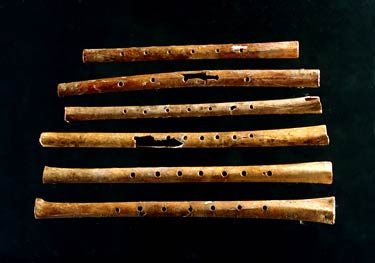
Gudi ("Bone Flutes") are the oldest known musical instruments from China dating back to around 7000 BC.
[China - Dizi (Flute) (Recent Recording)]

[Yellow River - considerably upstream from Jiahu]
In 1986, these bone flutes were excavated from an early neolithic tomb in Jiahu, a Neolithic Yellow River settlement

based in the central plains of ancient China, modern Wuyang, Henan Province. Archaeologists consider the site to be one of the earliest examples of the Peiligang culture. Settled from 7000 to 5800 BC, the site was later flooded and abandoned. The settlement at Jiahu was surrounded by a moat and covered an area of 55,000 square metres. Discovered by Zhu Zhi in 1962, extensive excavation of the site did not occur until much later. Most of the site has still not yet been excavated.

The average size of the bone flute is approximately 20 cm long and 1.1 cm in diameter, and the bone flutes are made from the wings of the red-crowned crane.
The Red-Crowned Crane (Grus japonensis), also called the Japanese Crane or Manchurian Crane, is a large crane and is the second rarest crane in the world. In East Asia, it is known as a symbol of luck and fidelity. At 55 inches high, the crane does not make easy prey, for all that it stands out in its natural habitat of marshes and swamps. When it matures, the Red-crowned Crane is snow white with a patch of red skin on its head. This patch of skin becomes bright red when the crane becomes angry or excited. This species is the heaviest crane, typically 17-22 pounds, although large Sarus Cranes are taller. The maximum weight a male Red-Crowned Crane is 33 pounds.
In Japan, this crane, known as tancho, is said to live 1000 years. A pair of Red-crowned Cranes were used in the design for the D series of the 1000 yen note. In the Ainu language, the Red-crowned Crane is known as sarurun kamui or marsh kamui.
In China, the Red-crowned Crane is often featured in myths and legends. In Taoism, the Red-crowned Crane is a symbol of longevity and immortality. In art and literature, immortals are often depicted riding on cranes. A mortal who attains immortality is similarly carried off by a crane. Reflecting this association, Red-crowned Cranes are called xian he, or fairy crane. The Red-crowned Crane is also a symbol of nobility. Depictions of the crane have been found in Shang Dynasty tombs and Zhou Dynasty ceremonial bronzeware. A common theme in later Chinese art is the reclused scholar who cultivates bamboo and keeps cranes.
The open-ended bone flutes have a variety of number of holes, ranging from one to eight holes (in the latter case, seven in front and one in back). The bone whistles are much shorter with lengths from 5.7 cm to 10.5 cm long with only a couple of holes. Lee and Shen believed that the Chinese understood the "resonance of an air column" and were able to create an instrument that contained their "complete interval preference of Chinese music." Blowing into an end-blown bone flutes produces the same effect as blowing into a glass bottle. It was also believed that the eight open holes flute could play "all harmonic intervals and two registers."
These harmonic intervals are said to be a "function of culture" and were of a larger set compared to the West. Bone flutes were also used for sacrificial purposes as well as bird hunting. Gudi are not very common now, but there are still people who continue to use these flutes for their music.
***
The number of an interval is determined by counting the number of degrees between the two notes beginning with one for the lower note (i.e. the total number of letter names involved from the lower note to the higher). The number of degrees between C and G for example is 5 (CDEFG -- five letter names or 12345 -- five scale degrees), therefore the interval is a fifth.
The name of any interval is further qualified using the terms such as perfect, major, and minor.
This is called its interval quality.
A perfect unison occurs between notes of the same pitch, a distance of zero half steps.
0 steps = P1 (Perfect Unison)
A second that contains a half step is called a minor second.
1/2 step = m2 (Minor Second)
A second that contains a whole step is called a major second
1 step = M2 (Major Second)
A third that contains 1 1/2 steps is called a minor third
1 1/2 steps = m3 (Minor Third)
A third that contains 2 steps is called a major third
2 steps = M3 (Major Third)
***

Ethnomusicology commonly classifies pentatonic scales as either anhemitonic or hemitonic.
Anhemitonic scales do not contain half steps.
The Chinese C major pentatonic scale contains only major seconds and minor thirds between adjacent notes.
C - D - E - G - A - C
M2 M2 m3 M2 m3
[3500 Iraq / 2000 China Flutes / 1998 Yurok California]
